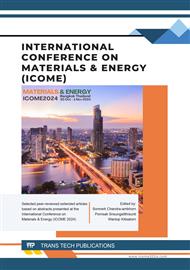[1]
Y. Xiang, S. Zhang, Z. Wei, J. Li, P. Wei, Z. Chen, L. Yang, and L. Jiang, Forming and defect analysis for single track scanning in selective laser melting of Ti6Al4V, Applied Physics A 124 (2018) 685.
DOI: 10.1007/s00339-018-2056-9
Google Scholar
[2]
C. Wei, L. Li, X. Zhang, and Y.-H. Chueh, 3D printing of multiple metallic materials via modified selective laser melting, CIRP Annals 67 (2018) 245-248.
DOI: 10.1016/j.cirp.2018.04.096
Google Scholar
[3]
W. Ge, J. Y. H. Fuh, and S. J. Na, Numerical modelling of keyhole formation in selective laser melting of Ti6Al4V, Journal of Manufacturing Processes 62 (2021) 646-654.
DOI: 10.1016/j.jmapro.2021.01.005
Google Scholar
[4]
C. Qiu, C. Panwisawas, M. Ward, H. C. Basoalto, J. W. Brooks, and M. M. Attallah, On the role of melt flow into the surface structure and porosity development during selective laser melting, Acta Materialia 96 (2015) 72-79.
DOI: 10.1016/j.actamat.2015.06.004
Google Scholar
[5]
X. Shi, C. Yan, W. Feng, Y. Zhang, and Z. Leng, Effect of high layer thickness on surface quality and defect behavior of Ti-6Al-4V fabricated by selective laser melting, Optics & Laser Technology 132 (2020) 106471.
DOI: 10.1016/j.optlastec.2020.106471
Google Scholar
[6]
P. Ninpetch, P. Kowitwarangkul, S. Mahathanabodee, P. Chalermkarnnon, and P. Rattanadecho, Computational investigation of thermal behavior and molten metal flow with moving laser heat source for selective laser melting process, Case Studies in Thermal Engineering 24 (2021) 100860.
DOI: 10.1016/j.csite.2021.100860
Google Scholar
[7]
L. Cao, Numerical simulation of the impact of laying powder on selective laser melting single-pass formation, International Journal of Heat and Mass Transfer 141 (2019) 1036-1048.
DOI: 10.1016/j.ijheatmasstransfer.2019.07.053
Google Scholar
[8]
X. Ao, J. Liu, H. Xia, and Y. Yang, A numerical study on the mesoscopic characteristics of Ti-6Al-4V by selective laser melting, Materials (Basel) 15 (2022) 2850.
DOI: 10.3390/ma15082850
Google Scholar
[9]
M. R. Azadi Tinat, M. Uddagiri, I. Steinbach, and I. López-Galilea, Numerical simulations to predict the melt pool dynamics and heat transfer during single-track laser melting of Ni-based superalloy (CMSX-4), Metals 13 (2023) 1091.
DOI: 10.3390/met13061091
Google Scholar
[10]
R. Thongpron, P. Ninpetch, P. Chalermkarnnon, and P. Kowitwarangkul, Effect of hatch spacing in selective laser melting process of Ti-6Al-4V alloy on finished surface roughness: A computational study, Journal of Metals, Materials and Minerals 34 (2024) 1861.
DOI: 10.55713/jmmm.v34i3.1861
Google Scholar
[11]
C. H. Fu and Y. B. Guo, Three-dimensional temperature gradient mechanism in selective laser melting of Ti-6Al-4V, ASME Journal of Manufacturing Science and Engineering 136 (2014) 061004.
DOI: 10.1115/1.4028539
Google Scholar
[12]
K. C. Mills, Recommended Values of Thermophysical Properties for Selected Commercial Alloys, Woodhead Publishing Series in Metals and Surface Engineering (2002) 211-217.
DOI: 10.1533/9781845690144.211
Google Scholar
[13]
D. Kouprianoff, I. Yadroitsava, A. du Plessis, N. Luwes, and I. Yadroitsev, Monitoring of laser powder bed fusion by acoustic emission: Investigation of single tracks and layers, Frontiers in Mechanical Engineering 7 (2021) 678076.
DOI: 10.3389/fmech.2021.678076
Google Scholar
[14]
Q. Chen, Y. Zhao, S. Strayer, Y. Zhao, K. Aoyagi, Y. Koizumi, A. Chiba, W. Xiong, and A. C. To, Elucidating the effect of preheating temperature on melt pool morphology variation in Inconel 718 laser powder bed fusion via simulation and experiment, Additive Manufacturing 37 (2021) 101642.
DOI: 10.1016/j.addma.2020.101642
Google Scholar
[15]
X. Chen, W. Mu, X. Xu, W. Liu, and L. Huang, Numerical analysis of double track formation for selective laser melting of 316L stainless steel, Applied Physics A 127 (2021) 586.
DOI: 10.1007/s00339-021-04728-x
Google Scholar
[16]
Y. Xiang, S. Zhang, Z. Wei, J. Li, P. Wei, Z. Chen, L. Yang, and L. Jiang, Forming and defect analysis for single track scanning in selective laser melting of Ti6Al4V, Applied Physics A 124 (2018) 685.
DOI: 10.1007/s00339-018-2056-9
Google Scholar



